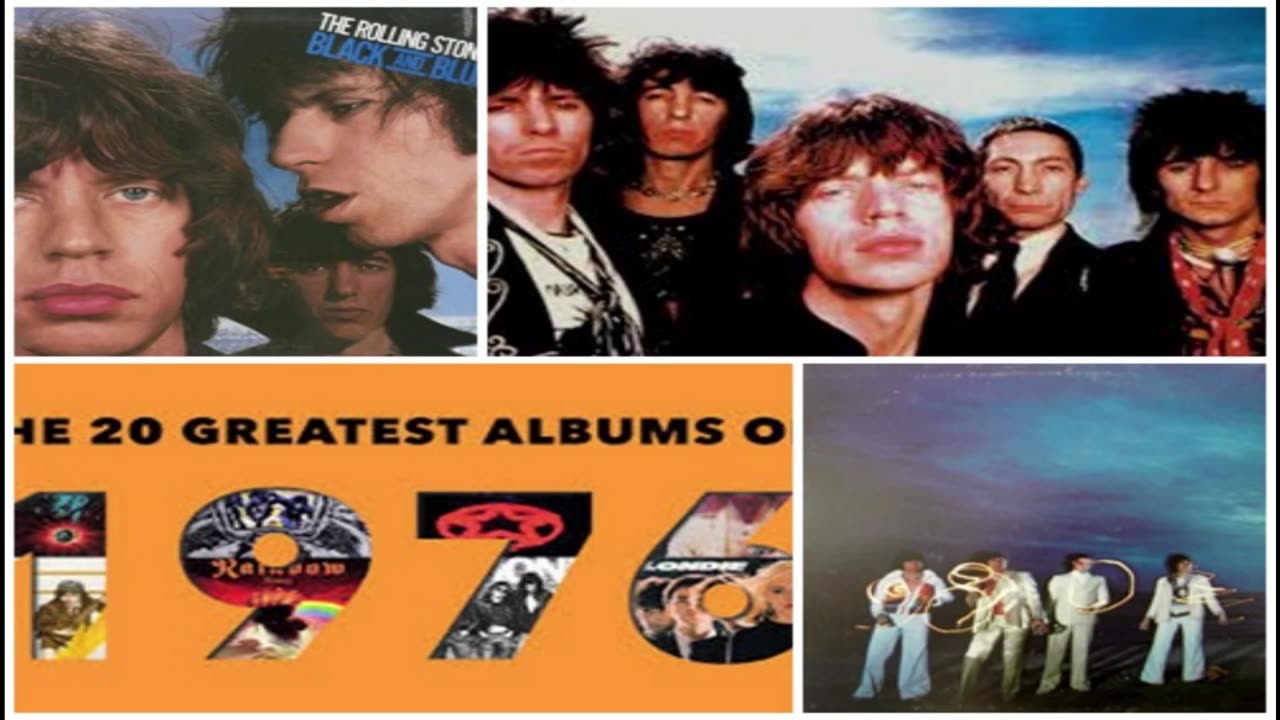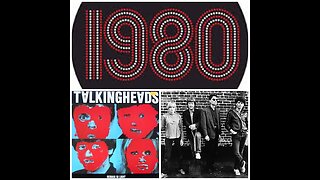Premium Only Content

My Top 20 Albums from 1976 No 20
Black and Blue by The Rolling Stones
Track listing
All tracks are written by Mick Jagger and Keith Richards, except where noted
Side one
1. "Hot Stuff" 5:20
2. "Hand of Fate" 4:28
3. "Cherry Oh Baby" Eric Donaldson 3:57
4. "Memory Motel" 7:07
Side twoNo. Title Length
5. "Hey Negrita" (inspiration by Ron Wood) 4:59
6. "Melody" (inspiration by Billy Preston) 5:47
7. "Fool to Cry" 5:03
8. "Crazy Mama" 4:34
Personnel
The Rolling Stones
Mick Jagger – lead vocals (all tracks), backing vocals (1, 3, 4), percussion (1), piano (4), electric piano (7), electric guitar (8)
Keith Richards – electric guitar (all but 4), backing vocals (1–5, 8), electric piano (4), bass guitar and piano (8), co-lead vocals (4)
Ronnie Wood – electric guitar (3, 5, 8), backing vocals (1, 2, 4, 5, 8)
Bill Wyman – bass guitar (all but 8), percussion (1)
Charlie Watts – drums (all tracks), percussion (1)
Additional personnel
Billy Preston – piano (1, 2, 4–6, 8), organ (5, 6), electric piano, ARP String Ensemble (4), percussion (6), backing vocals (1, 4–6)
Nicky Hopkins – piano and synthesiser (7), organ (3)
Harvey Mandel – electric guitar (1, 4)
Wayne Perkins – electric guitar (2, 7), acoustic guitar (4)
Ollie E. Brown – percussion (1–3, 5, 8)
Ian Stewart – percussion (1)
Arif Mardin – horn arrangement (6)
Technical
Engineers – Keith Harwood, Glyn Johns, Phil McDonald, Lew Hahn (edit)
Assistant engineers – Jeremy Gee, Dave Richards, Tapani Tapanainen, Steve Dowd, Gene Paul
Lee Hulko – LP mastering at Sterling Sound (original 1976)
Robert Ludwig – CD mastering at Gateway Mastering Studios (1994 Virgin issue)
Bea Fleiter – art director[27]
Hiro – photograph[28]
"Memory Motel"
Hannah honey was a peachy kind of girl
Her eyes were hazel
And her nose was slightly curved
We spent a lonely night at the Memory Motel
It's on the ocean, I guess you know it well
It took a starry night to steal my breath away
Down on the waterfront
Her hair all drenched in spray
Hannah baby was a honey of a girl
Her eyes were hazel
And her teeth were slightly curved
She took my guitar and she began to play
She sang a song to me
Stuck right in my brain
You're just a memory of a love
That used to be
You're just a memory of a love
That used to mean so much to me
She got a mind of her own
And she use it well, yeah
Well she's one of a kind
Got a mind
She got a mind of her own, yeah
And she use it mighty fine
She drove a pick-up truck
Painted green and blue
The tires were wearing thin
She done a mile or two
When I asked her where she headed for
"Back up to Boston I'm singing in a bar"
I got to fly today on down to Baton Rouge
My nerves are shot already
The road ain't all that smooth
Across in Texas is the rose of San Antone
I keep on a feeling that gnawing in my bones
You're just a memory of a love
That used to mean so much to me
You're just a memory girl
You're just a sweet memory
And it used to mean so much to me
Sha la la la la
You're just a memory of a love
That used to mean so much to me
She got a mind of her own
And she use it well, yeah
Mighty fine
'Cause she's one of a kind
She got a mind of her own
She's one of a kind
And she use it well
On the seventh day my eyes were all a glaze
We've been ten thousand miles
Been in fifteen states
Every woman seemed to fade out of my mind
I hit the bottle I hit the sack and cried
What's all this laughter on the 22nd floor
It's just some friends of mine
And they're busting down the door
Been a lonely night at the Memory Motel
You're just a memory girl, just a memory
And it used to mean so much to me
You're just a memory girl, you're just a memory
And it used to mean so much to me
You're just a memory girl, you're just a sweet old memory
And it used to mean so much to me
You're just a memory of a love that used to mean so much to me
She's got a mind of her own and she use it well yeah
Well she's one of a kind
"Fool To Cry"
When I come home baby
And I've been working all night long
I put my daughter on my knee, and she said
"Daddy what's wrong?"
She whispered in my ear so sweet
You know what she said?
She said
"Daddy you're a fool to cry
You're a fool to cry
And it makes me wonder why."
Daddy, you're a fool"
You know, I got a woman
(Daddy, you're a fool)
And she live in the poor part of town
And I go see her sometimes
And we make love, so fine
I put my head on her shoulder
She said, "Tell me all your troubles."
You know what she said? she said
"Daddy you're a fool to cry
You're a fool to cry
And it makes me wonder why."
Daddy you're a fool to cry
Oh, I love you so much baby
Daddy you're a fool to cry
Daddy you're a fool to cry, yeah
She said, "Daddy you're a fool to cry
You're a fool to cry
And it makes me wonder why."
She said, "Daddy you're a fool to cry
Daddy you're a fool to cry
Daddy you're a fool to cry
Daddy you're a fool to cry
Even my friends say to me sometimes
I make out like I don't understand them
You know what they say?
They say, "Daddy you're a fool to cry
You're a fool to cry
And it makes me wonder why."
I'm a fool baby
I'm a fool baby
I'm a certified fool
I want to tell ya
Gotta tell ya, baby
I'm a fool baby
I'm a fool baby
Come on
I'm a fool
I'm a fool
I'm a fool
Black and Blue is the thirteenth studio album by the English rock band the Rolling Stones, released on 23 April 1976 by Rolling Stones Records.
This album was the first record after former guitarist Mick Taylor quit in December 1974. As he had done the previous time the Stones were between second guitarists in 1968, Keith Richards recorded the bulk of the guitar parts himself, though the album recording sessions also served as an audition for Taylor's replacement. Richards said of the album that it was used for "rehearsing guitar players, that's what that one was about."[3] Numerous guitarists showed up to auditions; those who appeared on the album were Wayne Perkins, Harvey Mandel, and Ronnie Wood. Wood had previously contributed to the title track from the It's Only Rock 'n Roll album, and became a temporary touring member of the Stones in 1975 and official member in 1976. The Stones rhythm section of bassist Bill Wyman and drummer Charlie Watts appear on nearly all tracks, and frequent collaborators Nicky Hopkins and Billy Preston play keyboards on most of the album, with percussionist Ollie E. Brown also appearing on about half of the tracks. The album was the second to be self-produced, credited to "The Glimmer Twins", a pseudonym used by Jagger and Richards for their roles as producers.
Black and Blue showed the band blending their traditional rock and roll style with heavy influences from reggae and funk music. Only one single from the album, "Fool to Cry", had any significant chart success, and reception to the album was mixed. The album received a few positive reviews at the time of release, though many reviewers found it mostly forgettable, and tended to rank it very low compared to prior Stones releases. Retrospective reviews from more recent publications such as AllMusic have been kinder to the album, with critic Stephen Thomas Erlewine stating that the album's "being longer on grooves and jams than songs" ended up being "what's good about it".[5]
History
The Rolling Stones returned to Munich, Germany, in December 1974—where they had recorded their previous album It's Only Rock 'n' Roll—and began the recording of their new album at Musicland Studios, with Mick Jagger and Keith Richards (as the Glimmer Twins) producing again. With a view to releasing it in time for a summer 1975 Tour of the Americas, the band broke for the holidays and returned in January in Rotterdam, Netherlands, to continue working—all the while auditioning new guitarists as they recorded. Among the hopefuls were Steve Marriott, Harvey Mandel, Wayne Perkins, Peter Frampton, and Ronnie Wood (although only Mandel, Perkins and Wood's guitar work would appear on the finished album). Guitar heroes Rory Gallagher and Jeff Beck both went over for a jam with the band "just to see what was going on," but both declined interest in joining the group, happy with their solo careers. Jeff Beck stated that, "in two hours I got to play three chords – I need a little more energy than that." Beck's jamming with the Stones remains unreleased to date, but is available on bootleg recordings. With much work to follow, it was decided to delay the album for the following year and release the Made in the Shade compilation instead. "Cherry Oh Baby" (which was a cover version of Eric Donaldson's 1971 reggae song) would be the only song from the upcoming album sporadically played on the 1975 Tour of the Americas.
Following the conclusion of the tour, the band went to Montreux, Switzerland, in October for some overdub work, returning to Musicland Studios in Munich in December to perform similar work. After some final touch-ups, Black and Blue was completed in New York City in February 1976. That month the Stones flew to Sanibel Island Beach on Sanibel Island, Florida, to be photographed by fashion photographer Hiro for the album cover art.[6]
Stylistically, Black and Blue embraces hard rock with "Hand of Fate" (solo by Wayne Perkins) and "Crazy Mama"; funk with "Hot Stuff" (solo by Harvey Mandel); reggae with their cover of "Cherry Oh Baby" (Ronnie Wood and Keith Richards weaving guitars); and blues with "Melody," featuring the talents of Billy Preston – a heavy contributor to the album. Musical and thematic styles were merged on the seven-minute "Memory Motel," with both Jagger and Richards contributing lead vocals to a love song embedded within a life-on-the-road tale.
While all the album's songs except "Cherry Oh Baby" were officially credited to Jagger/Richards as authors, the credit for "Hey Negrita" specifies "Inspiration by Ron Wood" and "Melody" lists "Inspiration by Billy Preston". Bill Wyman would later release a version of "Melody" with his Rhythm Kings, crediting Preston as author. "Melody" is based on "Do You Love Me" by Billy Preston and Bruce Fisher, from Preston's 1973 album Everybody Likes Some Kind of Music. The only song to include both session players Wayne Perkins and Harvey Mandel is Memory Motel where Perkins plays acoustic, Mandel electric, but without a guitar solo.
Two extra tracks recorded in the Rotterdam sessions were later released on 1981's Tattoo You: "Slave" and "Worried About You" (guitar solo by Wayne Perkins).[7]
Release and reception
Released on 23 April 1976[8] – with "Fool to Cry", a worldwide top 10 hit, as its lead single – Black and Blue reached No. 2 in the UK and spent an interrupted four-week spell at number 1 in the United States, going platinum there.
The album was promoted with a controversial billboard on Sunset Boulevard in Hollywood that depicted the model Anita Russell, bound by Jagger[9] under the phrase "I'm Black and Blue from the Rolling Stones – and I love it!" The billboard was removed after protests by the feminist group Women Against Violence Against Women, although it earned the band widespread press coverage.[10]
Critical view was polarised. According to writer Bud Scoppa, some critics were bewildered by the album, while others dismissed it for its dissimilarities to Exile on Main St. (1972), which by then had become regarded as the group's best work.[20] Author Gary J. Jucha describes the mixed critical reaction as typical of "most progressive albums by an established recording artist."[8]
Lester Bangs wrote in Creem that "the heat's off, because it's all over, they really don't matter anymore or stand for anything [...] this is the first meaningless Rolling Stones album, and thank God".[21] However, Robert Christgau commended the band for taking musical risks, and singled out "Hot Stuff" and "Fool to Cry" for particular praise before concluding: "diagnosis: not dead by a long shot".[22] He also felt that the album represents the Stones' biggest exploration of black rhythms and styles since December's Children (1965).[22] Bill Cosford of The Miami Herald highlighted the record as a musical departure for the band, writing: "Black and Blue is not a rock album. It is a sampler, of sorts, a musical term paper. In it the Stones examine the several influences on pop music today: salsa, disco, reggae. By and large, they do so superbly. But in committing themselves to exercises in musical formulae as tight as these, the Stones attach their music to styles subject to rapid eclipse."[23]
Retrospectively, Stephen Thomas Erlewine of AllMusic praised the album for being "longer on grooves and jams than songs", which he felt was inevitable as it was recorded while the Stones auditioned a replacement for Taylor, and for profiling the band's musical chemistry. He felt that "groove and sound" characterise the record, generally eschewing straight rock songs for reggae, funk and disco excursions that "sound like integral parts of the Stones' lifeblood".[11] Bud Scoppa of Uncut described the record as an "unlikely triumph", with the groove-oriented material and guesting "hotshot musicians" combining for strong performances, "expertly brought out by the ultra-dry sonics of engineers Glyn Johns and Keith Harwood". He wrote: "Forty-one minutes of super-tight, bone-dry, hi-fi rock and soul, Black and Blue is one of the Stones' most underrated albums – the only Stones LP to focus primarily on feel rather than subject matter."[20]
Less favourably, The Rough Guide to Rock contributor Peter Shapiro wrote that following the addition of Wood to their line-up, the Stones slowly transformed into "caricatures of the worst rock'n'roll excesses", adding that on Black and Blue, the group "tried to answer LeRoi Jones's comment that white people were 'the keepers of last year's blues' by appropriating contemporary funk and reggae stylings, with mixed results."[24] Colin Larkin of The Encyclopedia of Popular Music wrote that the album "showed the group seeking a possible new direction playing variants on white reggae, but the results were less than impressive."[13] Similarly, Martin C. Strong of The Great Rock Discography noted that the record saw "[Wood] brought into the fold and a half hearted attempt at reggae stylings".[25] In The Rolling Stone Album Guide, Black and Blue is described as a "nearly song-free" album which works best on the sincere ballads "Fool to Cry" and "Memory Hotel" and "the silly but shitkicking cowboy tale 'Hand of Fate'."[17]
In 2000, Black and Blue was ranked at number 536 in Colin Larkin's All Time Top 1000 Albums.[26]
Legacy
In 1977, Keith Richards said that the album "wasn't very good – certainly nowhere as good as Let It Bleed", though he reappraised the record in 1984. Mick Jagger offered his assessment in the 1990s: "It was a bit of a holiday period. I mean, we cared, but we didn't care as much as we had, not really concentrating on the creative process."[20] Mick Taylor praised the album in a 1979 interview.[20]
In 1994, Black and Blue was remastered and reissued by Virgin Records, again in 2009 by Universal Music, and once more in 2011 by Universal Music Enterprises in a Japanese-only SHM-SACD version. The 1994 remaster was initially released in a Collector's Edition CD, which replicated in miniature many elements of the original gatefold album packaging.
-
 8:07
8:07
JohnVicarysMusicPassions
2 months agoMy Top 20 albums for 1980 No 8
17 -
 LIVE
LIVE
Game On!
13 hours ago $1.63 earnedFeel Good Friday! Breaking down the Final 4!
22,099 watching -
 1:02:20
1:02:20
TheDozenPodcast
19 hours agoAttempted TERROR attack & visiting Tommy Robinson: Chas Symonds
12.9K5 -
 11:27
11:27
IsaacButterfield
1 day ago $2.47 earnedEngland Is Dangerous
9.66K19 -
 37:33
37:33
The Rich Dad Channel
1 day ago5 Shocking Predictions for 2025 (Best of Rich Dad Radio with Robert Kiyosaki)
11.5K2 -
 10:04
10:04
NinjaGamblers
22 hours ago $0.58 earnedHow The Romanovsky Roulette System Wins 86.48% of the Time!
7.83K4 -
 23:07
23:07
Uncommon Sense In Current Times
17 hours ago $0.59 earnedDefending Your Christianity Without Overcomplicating It (Part 2) | Greg Koukl
16.3K3 -
 5:08
5:08
Gun Owners Of America
18 hours agoDebunking Everytown's False Claims About Us
9.11K2 -
 1:00:59
1:00:59
Trumpet Daily
21 hours ago $4.50 earnedTrump Unites the World Against America - Trumpet Daily | Apr. 3, 2025
14.2K3 -
 4:13:56
4:13:56
Alex Zedra
11 hours agoLIVE! VERDANSK!!!!!
89.9K17